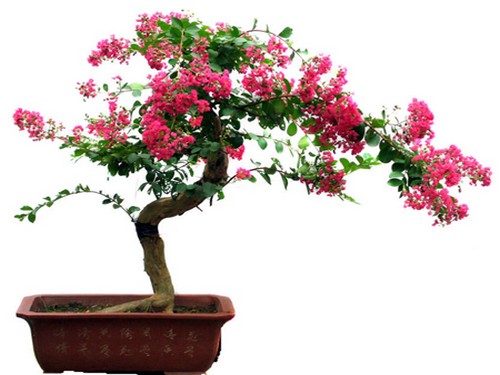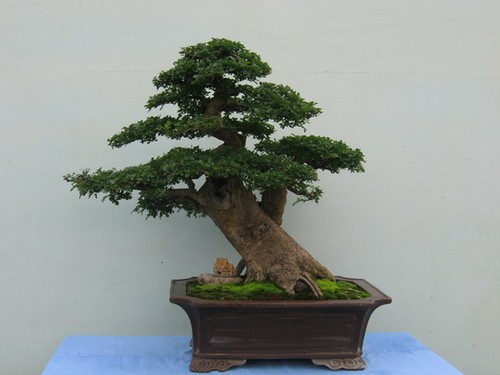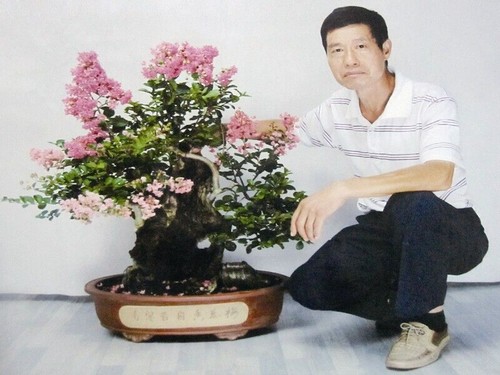Propagation method of crape myrtle bonsai
Crape myrtle trees have beautiful appearance, bright trunks, bright flowers and long flowering period. they can last for more than a hundred days in summer and autumn. they can be used for landscaping of courtyards, parks and green spaces, as well as potted plants. Crape myrtle is sunny, slightly shade-tolerant, drought-resistant, waterlogging-resistant, pruning-resistant and tillering-resistant. It also grows well on lime soil and has strong cold resistance. The reproduction of crape myrtle can be done by sowing, cutting, striping, splitting, grafting and so on.

1. Sowing method:
The mature seeds were collected from November to December, dried and buried in the sand and placed in a cool place to survive the winter. Sowing from late February to early March, wide banner sowing or sowing, covered with a layer of fine charred plaster, with no seeds, covered with grass. After more than 10 days of germination, the grass can be uncovered in time, and the seedlings can be selected after rain when two pairs of true leaves appear in the seedlings; weeding frequently at the seedling stage, applying thin fertilizer 3 times from June to July, irrigation to prevent drought in summer, and the seedling height at the end of the year is about 40m / 50cm. The strong growth can be cut off in time, and the Spring Equinox will transplant and grow up the following year.
2. Cutting propagation:
① hardwood cuttings: collect annual branches before spring sprouting, cut them into about 15cm cuttings, insert loose, well-drained sandy loam seedbed, insert 2Compact 3 to water thoroughly, use film to build arch shed to close, seedlings grow into 15mur20cm can lift the film, change into shading net, timely watering, the branches can grow to about 6050cm in the same year.
② softwood cuttings can be carried out from the first ten days of June to the first and middle of September, when the new branches grow vigorously and have the most vitality. Take an annual strong branch of about 15cm, insert it into the seedbed, and pour it thoroughly. At this time, use the shade net and the film to build an arch shed to protect it at the same time, about 50 days, remove the film, retain the shade net, and then water it at the right time, the branches can grow to about 60cm and 80cm in the same year, and the survival rate is very good.
There are two common types of reproduction and asexual reproduction:
1. Sexual reproduction: seeds generally harvested in 9mura-November are sown from February to March in the following year, and the emergence rate is more than 95%. The germination temperature of the seeds is from 15 ℃ to 25 ℃. After sowing, the seeds are covered with about 2 mm of soil and covered with film to keep warm and moisturizing.
2. Asexual reproduction: it is divided into cutting, ramet, grafting and other propagation methods.
Cutting propagation: there are two kinds of hardwood cutting in spring and softwood cutting in summer.
A. Hardwood cuttings: 1-2-year-old branches with strong growth and no diseases and insect pests were selected in spring and cut before sprouting. Choose the leeward and sunny place to do the inserting bed, which can also be carried out in a basin. Generally, the cuttings are 10 / 15 cm long and 8 / 12 cm in length. After cutting, the cuttings are poured with water, covered with film, insulated and moisturized. The cuttings can sprout and take root after two months, and the survival rate can reach 98%.
B, tender wood cuttings: from May to July, when the branches are semi-lignified, they can be cut in sand beds and bowls, cutting about 5cm of semi-lignified branches of the same year, with 2 leaves left above. Press the trench according to the row spacing of 10 cm, plant spacing of 2 cm, insert soil 4tick 5, pour water thoroughly after insertion, cover with film shading net to cool and moisturize, spray water to branches or water into sand bed according to weather conditions, in case soil is dry and branches are short of water. It can take root in about half a month, and the survival rate can reach more than 95%.
C, ramet propagation: because of the strong sprouting of crape myrtle root, it is very easy to grow many seedlings at the base of crape myrtle. After defoliation in winter and before sprouting in spring, the seedlings with partial roots can be cut and separated with sharp tools, and the seedlings with partial roots can be planted elsewhere.
Time: 2019-06-12 Click:
- Prev

Water Source Management of White Wax Bonsai in four Seasons
With slow growth, long life, beautiful tree shape and intertwined roots, it is the best of gardens, bonsai and root carvings, and is known as the king of living fossils and bonsai. In the daily water source management work, the white wax bonsai can be summarized by flood. Flood: there must be enough water. It is better to be wet than dry. Water more in spring
- Next

Seedling raising method of crape myrtle bonsai
Each kind of flower is blooming its own beauty, each leading a coquettish side. Like crape myrtle, it avoids the spring when a hundred flowers compete for beauty and chooses to bloom in summer and autumn. It has beautiful trees, buckled branches and colorful flowers, so it is worth watching. Crape myrtle has many kinds and different postures. Because it is easy to manage, the branches are soft.
Related
- Fuxing push coffee new agricultural production and marketing class: lack of small-scale processing plants
- Jujube rice field leisure farm deep ploughing Yilan for five years to create a space for organic food and play
- Nongyu Farm-A trial of organic papaya for brave women with advanced technology
- Four points for attention in the prevention and control of diseases and insect pests of edible fungi
- How to add nutrient solution to Edible Fungi
- Is there any good way to control edible fungus mites?
- Open Inoculation Technology of Edible Fungi
- Is there any clever way to use fertilizer for edible fungus in winter?
- What agents are used to kill the pathogens of edible fungi in the mushroom shed?
- Rapid drying of Edible Fungi

